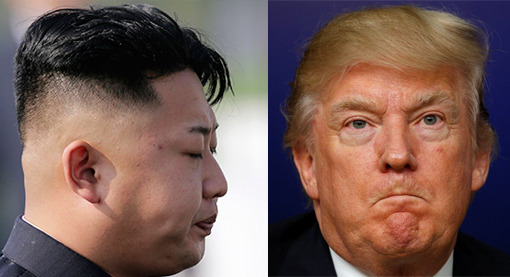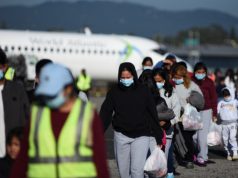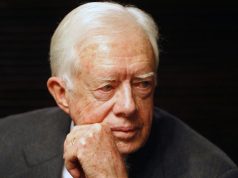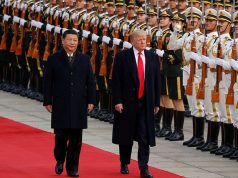BEDMINSTER, N.J./BEIJING — (UPDATE – 12:13 p.m) President Donald Trump warned North Korea on Tuesday it would face “fire and fury” if it threatens the United States, prompting the nuclear-armed nation to say it was considering firing missiles at Guam, a U.S.-held Pacific island.
As tensions escalated, Pyongyang said it was “carefully examining” a plan to strike Guam, site of a U.S. military base. A North Korean military spokesman, in a statement carried by state-run KCNA news agency, said the plan would be put into practice once leader Kim Jong Un makes a decision.
In another statement citing a different military spokesman, North Korea said it could carry out a pre-emptive operation if there were signs of a U.S. provocation.
Washington has warned it is ready to use force if need be to stop North Korea’s ballistic missile and nuclear programs but that it prefers global diplomatic action, including sanctions.
The consequences of any U.S. strike would potentially be catastrophic not only for North Koreans but also South Korea, Japan and the thousands of U.S. military personnel within range of any North Korean retaliatory strikes.
“North Korea best not make any more threats to the United States. They will be met with fire and fury like the world has never seen,” Trump told reporters at the Trump National Golf Club in Bedminster, New Jersey.
WATCH THE REUTERS TV VIDEO:
The U.N. Security Council unanimously imposed new sanctions on North Korea on Saturday over its continued missile tests that could slash the reclusive country’s $3 billion annual export revenue by a third.
North Korea has made no secret of plans to develop a nuclear-tipped missile able to strike the United States and has ignored international calls to halt its nuclear and missile programs.
It says its intercontinental ballistic missiles are a legitimate means of defense against perceived U.S. hostility. It has long accused the United States and South Korea of escalating tensions by conducting military drills.
U.S. stocks closed slightly lower after Trump’s comment, while a widely followed measure of stock market anxiety ended at its highest in nearly a month. The U.S. dollar index pared gains and the safe-haven yen strengthened against the U.S. currency.
Tensions rise
The United States has remained technically at war with North Korea since the 1950-53 Korean conflict ended in an armistice rather than a peace treaty. The past six decades have been punctuated by periodic rises in antagonism and rhetoric that have always stopped short of a resumption of active hostilities.
Tensions have risen since North Korea carried out two nuclear bomb tests last year and two ICBM tests last month.
Republican U.S. Senator John McCain said Trump should tread cautiously when issuing threats to North Korea unless he is prepared to act.
“I take exception to the president’s comments because you got to be sure you can do what you say you’re going to do,” he said in a radio interview.
The Trump administration’s attempts to pressure North Korea into abandoning its nuclear and missile ambitions have so far gained little traction.
U.S. Defense Secretary Jim Mattis has warned of an “effective and overwhelming” response against North Korea if it chose to use nuclear weapons but has said any military solution would be “tragic on an unbelievable scale.”
The United States has 28,500 troops in South Korea to guard against the North Korean threat. Japan hosts around 54,000 U.S. military personnel, the U.S. Department of Defense says, and tens of thousands of Americans work in both countries.
Seoul is home to a population of roughly 10 million, within range of massed pre-targeted North Korean rockets and artillery, which would be impossible to destroy in a first U.S. strike.
The Washington Post reported on Tuesday that North Korea has successfully produced a miniaturized nuclear warhead that can fit inside its missiles, according to a confidential U.S. intelligence assessment.
But U.S. intelligence officials told Reuters that while North Korea has accelerated its efforts to design an ICBM, a miniaturized nuclear warhead, and a nosecone robust enough to survive reentry through the Earth’s atmosphere, there is no reliable evidence it has mastered all three, much less tested and combined them into a weapon capable of hitting targets in the United States.
“There’s a lot that we don’t know,” about the North Korean nuclear weapons program, including whether Pyongyang has developed “the guidance and control system, guidance and stability control, to move a rocket that distance without it breaking up,” U.S. Air Force General Paul Selva, the vice chairman of the Joint Chiefs of Staff, told the Air Force Association’s Mitchell Institute on Aug. 3.
U.S. intelligence officials, who spoke on condition of anonymity, also said there is no certainty about the number of nuclear warheads North Korea has assembled, with estimates ranging from 20 to as many as 60 and most experts leaning toward the lower end of that range.
North Korea’s ICBM tests last month suggested it was making technical progress, Japan’s annual Defence White Paper warned.
War of words
On Monday, U.S. Secretary of State Rex Tillerson held the door open for dialogue, saying Washington was willing to talk to Pyongyang if it halted its missile test launches.
Still, he maintained the pressure, urging Thailand on Tuesday for more action against Pyongyang.
Former U.S. diplomat Douglas Paal, now with the Carnegie Endowment for International Peace think tank in Washington, said Trump should not get into a war of words with Pyongyang.
“It strikes me as an amateurish reflection of a belief that we should give as we get rhetorically. That might be satisfying at one level, but it takes us down into the mud that we should let Pyongyang enjoy alone,” said Paal, who served as a White House official under previous Republican administrations.
Lockheed Martin Corp, the Pentagon’s No. 1 weapons supplier, said on Tuesday its customers are increasingly asking about missile defense systems.
The governor of Guam said North Korea’s warning of a possible missile strike was no threat and the island was prepared for “any eventuality,” with defenses strategically placed to protect its people.
“Guam is American soil … We are not just a military installation,” said Governor Eddie Calvo.
Calvo said in an online video message he had contacted the White House and had been told by the defense and homeland security departments there was no change in the threat level.
He said he would convene a meeting with Guam’s military commander and first responders to discuss their state of readiness.










